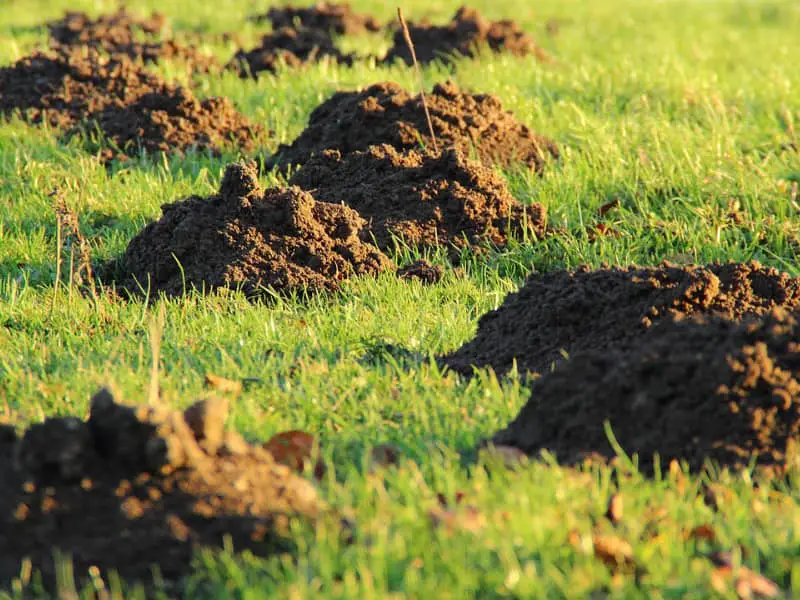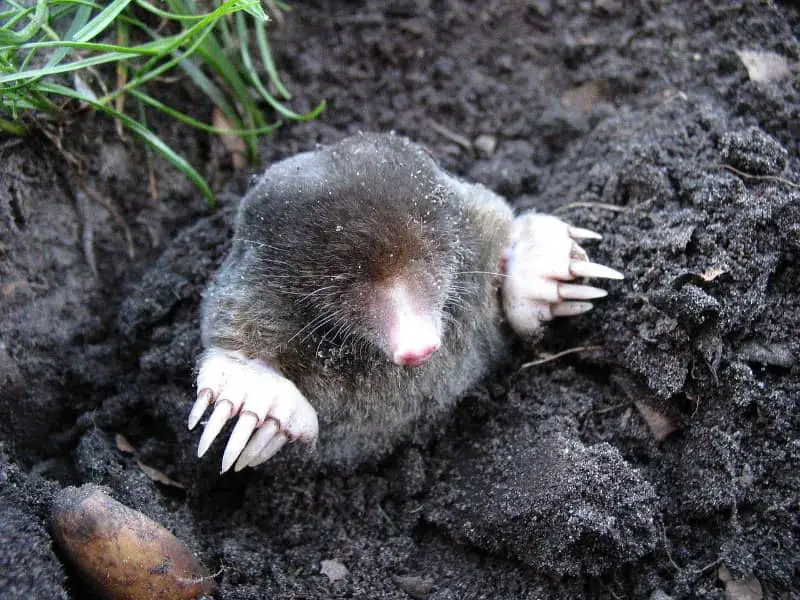
Catch mole
Catch a mole, many garden owners are concerned about this. The reason is that a mole, while useful, leaves unmissable molehills in the lawn and garden. These mounds not only look ugly to some people, but they also cause the lawn in that area to break. Therefore, it is understandable that some garden owners want to catch or drive away the mole.
Who gets to catch a mole?
First of all, we must point out that the mole is rightly protected in Germany. This means that he may neither be killed nor caught. Even live traps are prohibited. As a garden owner you are allowed to drive the mole away with natural methods. A natural method would be noise, which the mole does not tolerate and therefore seeks to escape.
However, there are exceptions to catch a mole. These are usually issued by the competent state authority for nature and environmental protection. Getting this exemption is not easy. Because you must have a very good reason to be allowed to catch a mole. This is also always under the condition that a live trap is used for this purpose.
One reason would be, for example, if the welfare, i.e. the life of the mole would be in danger. Here, each permit is carefully reviewed and a granted permit is always valid only for a live trap. If you receive such a permit, you are obliged to catch the mole alive and release it as soon as possible in a suitable place.
Unauthorized catching a mole, these penalties threaten
Quite rightly, very high penalties are imposed for the unauthorized capture or killing of moles. Even the attempt to capture an animal is punishable by a fine. Likewise, the tunnel systems may not be damaged or destroyed, as they serve as reproduction and resting places for the mole. This is also stipulated in the Nature Conservation Act in almost every federal state.
The penalties are huge and vary from state to state. In the most favorable case, the fine is 5000 € and a maximum of 65,000 €. This is listed in a special fine catalog of the respective nature conservation authority.
Catch mole, here's how
If you have an exemption from your state authority, then we can already tell you that it takes a lot of patience to catch a mole. The reason for this is that moles have good hearing and are very skittish towards other animals and humans. This means that when you catch a mole, the mole is quickly under stress.
This stress can even be fatal for the mole, if it is a very sensitive animal, it is possible that it will suffer a heart attack. Therefore, proceed very calmly and gently when you caught a mole using the following methods.
Live trap
Live traps are the method most widely used to catch the mole and release it in a place that is good for it. You should carefully consider where is a good place to release the mole even before catching it. The distance to the next residential area should be sufficiently large. This is because an active mole has a large territory, which not infrequently covers 2000 m² or more.
The idea of exposing the mole at the neighbor's house can so quickly lead to the fact that he will again adopt your garden as the base of his territory. The typical live traps are those that are tubular. Therefore, these are also called tube traps and are placed near a tunnel exit. The placement of the trap should be horizontal and the trap should be free of human odors.
So that no smell of you stuck to it, it is recommended to rinse the traps with water dissolved in the soil. A good supply of food should also be present in the trap. This can be insects or earthworms. Mostly earthworms are described as the best attractant. We recommend that you put a larger number of food animals in the live trap, as the scent is more intense for the mole and attracts it more quickly.
The mole will climb through a flap into the pipe trap and this flap closes again behind him. This flap can be opened only in one direction and thus the mole is trapped. When laying out such a trap, you need to check it every 20-30 minutes so that the animal does not have to stay in it for too long. You will notice that the little guy has an incredible amount of energy and makes quite a racket in the trap.
Catch the mole by hand
No kidding, this used to be done regularly by experienced gardeners. To do this, you only need to sacrifice a few hours of your time, and this still does not mean that you will be successful. During this time, observe the molehills in your garden to see if there is any movement. If you detect any movement, then quietly and quickly go to that molehill.
Then the fun really starts, you have to quickly and purposefully push the earth of the molehill aside with your hands and then carefully grab the mole, should it still be there, with both hands. You should have a dark box within reach to put the mole in. The box should also have some air holes so that the animal can breathe well.
This method of capture is as stressful for the animal as the live trap. However, it has the advantage that there is more space in the box, the animal can rest faster. With the live trap, 20 minutes can be an extremely long time for the mole. Catching the mole by hand works best in the early morning hours. Because that's when the animal is most active.
The right bait to catch a mole
In order for your hunt for the mole to be successful, you need to offer the right bait. If you have your own garden, the easiest way to get earthworms is to collect them yourself. You can collect them yourself by digging up a small piece of your garden with a spade. If you don't want to do that, you have the possibility to buy earthworms in different quantities.
If you have some left over after a successful mole hunt, simply plant them in the garden and they will make your soil nice and loose and airy. Another way to attract moles is to use mealworms and grubs. However, mealworms and earthworms have proven to be the best. It is always important that the worms are still alive, because then they smell better for the mole and taste better to him.
We have also discovered that some moles can be attracted with chocolate. However, you should see chocolate only as a supplement to the worms, because then, when the mole is trapped, it needs food. Chocolate is something to snack on, which the mole should not eat too much of, and it cannot replace a protein-rich food like the worms.
Mole caught, now what?
Before you set out to catch a mole, you should provide yourself with a box that meets some specifications. This is ideally made of wood, because the mole can quickly destroy a thin cardboard box with its claws. In a pinch, a plastic box would also do, which is made of dark material or can be quickly covered with a carpet.
After all, the mole does not like brightness. It is also important that there are air holes in the box. To do this, you should spread a layer of hay or straw on the floor, so that the mole does not slip on the slippery floor and what is at least as important that he does not start to freeze.
Mole caught, release as soon as possible
As we have already described above, after catching a mole it is essential that you also release it as soon as possible in a place that is suitable for it. Start thinking in advance about the best place to do this. A good habitat for a mole is a large meadow where there are no buildings and none are nearby.
Likewise, there should be no gardens in the vicinity and you should never set the mole down just a few 100 m from its previous habitat. Otherwise the probability is high that he will find his way back to your garden. Once the place is selected and you arrive there, take the box in which mole was transported and release him in a protected place.
The mole should climb out of the box on its own and you should not touch it unnecessarily with your hands. This would mean more stress for the mole in this phase, which you can simply avoid. We hope you will never have to catch a mole and thus save the animal and you stress.
Author

-
Garden animal - A life with nature
Welcome to my animal blog! My name is Dirk and I am happy to take you on my journey through the fascinating world of animals and gardening.
Born 54 years ago, I have had an insatiable curiosity for the animal world around me since childhood. Although I have moved professionally in other industries, my true passion has always been animals and nature. It is remarkable how a small garden has become such an important part of my life.
Many of my fondest memories are associated with the animals that share our home. Whether it's the curious squirrels that scurry across the trees in the morning, the colorful variety of birds that visit our feeders, or the busy bees and butterflies that pollinate our flowers, every moment with them is invaluable to me.
This blog is my contribution to share my experiences, discoveries and insights with like-minded people. Here I will share stories of unforgettable encounters with animals, give tips on gardening and creating wildlife-friendly habitats, and take you on my journeys through nature.
Thank you so much for being here!
Cordial,
Dirk aka garden animal
Last posts
- 27. February 2024PetsVeganes Hundefutter – Grün und Gesund?
- 18. January 2024ChickensOregano für Hühner
- November 27, 2023HamsterDiurnal hamsters
- November 24, 2023HamsterHamster hammock

